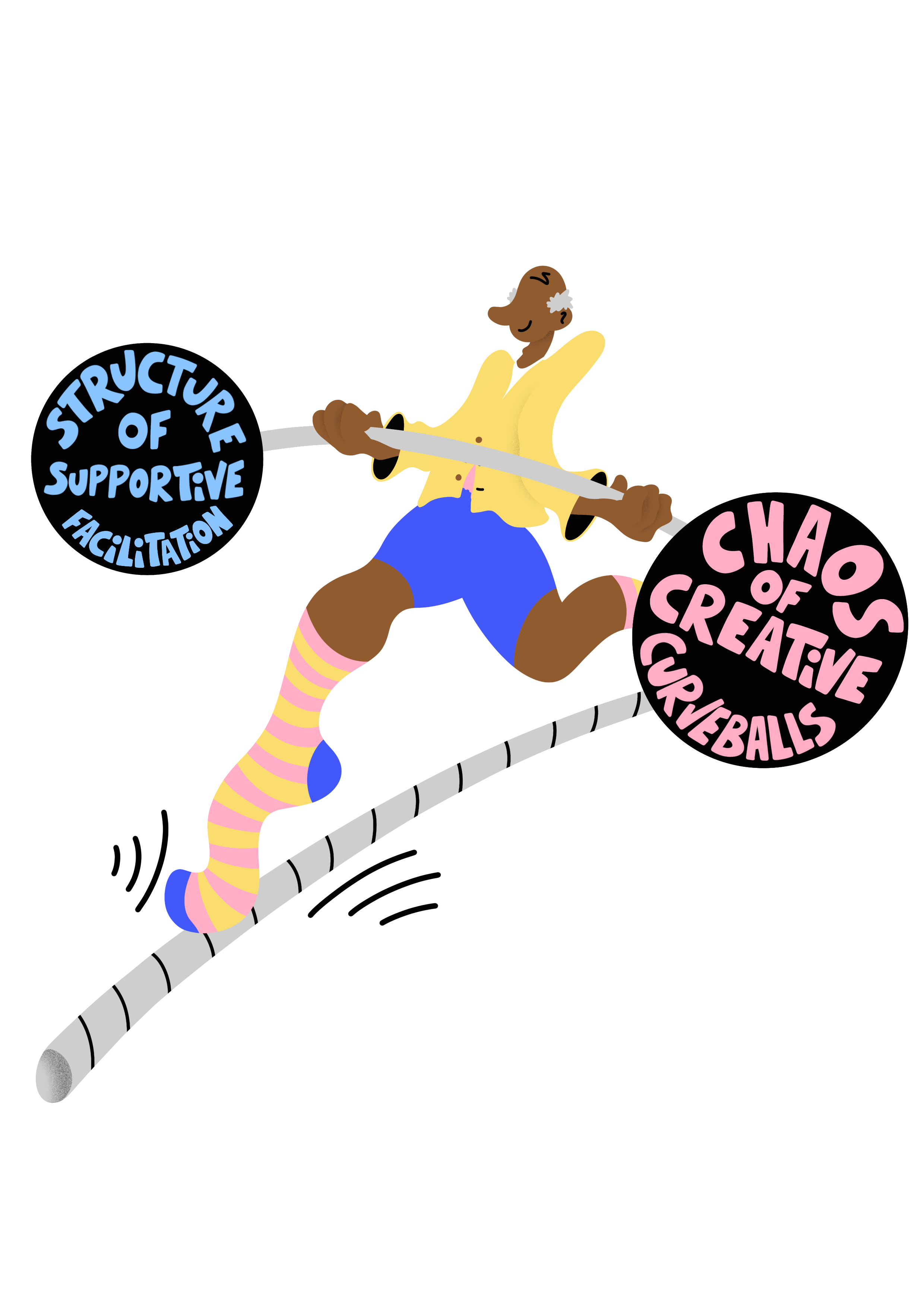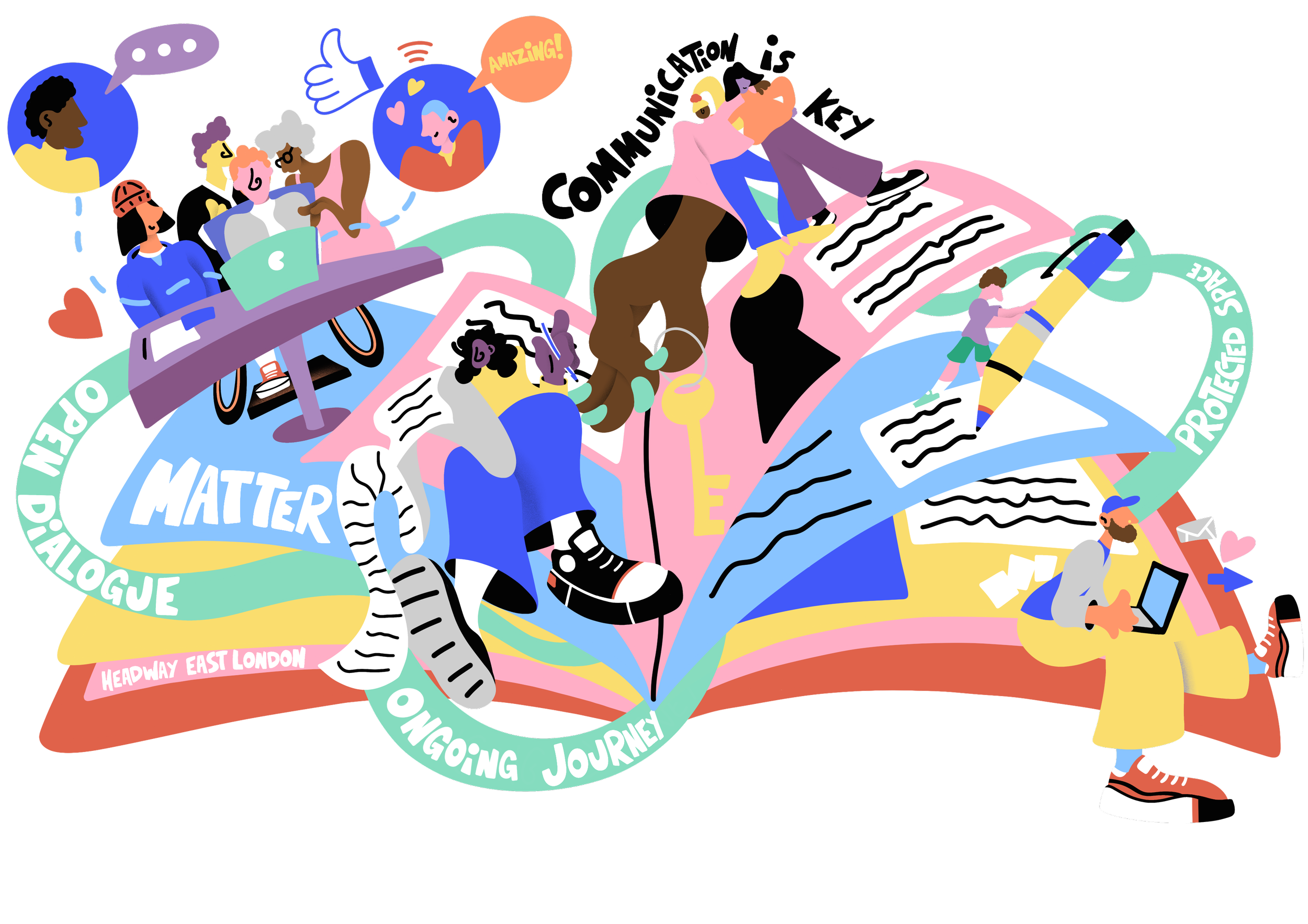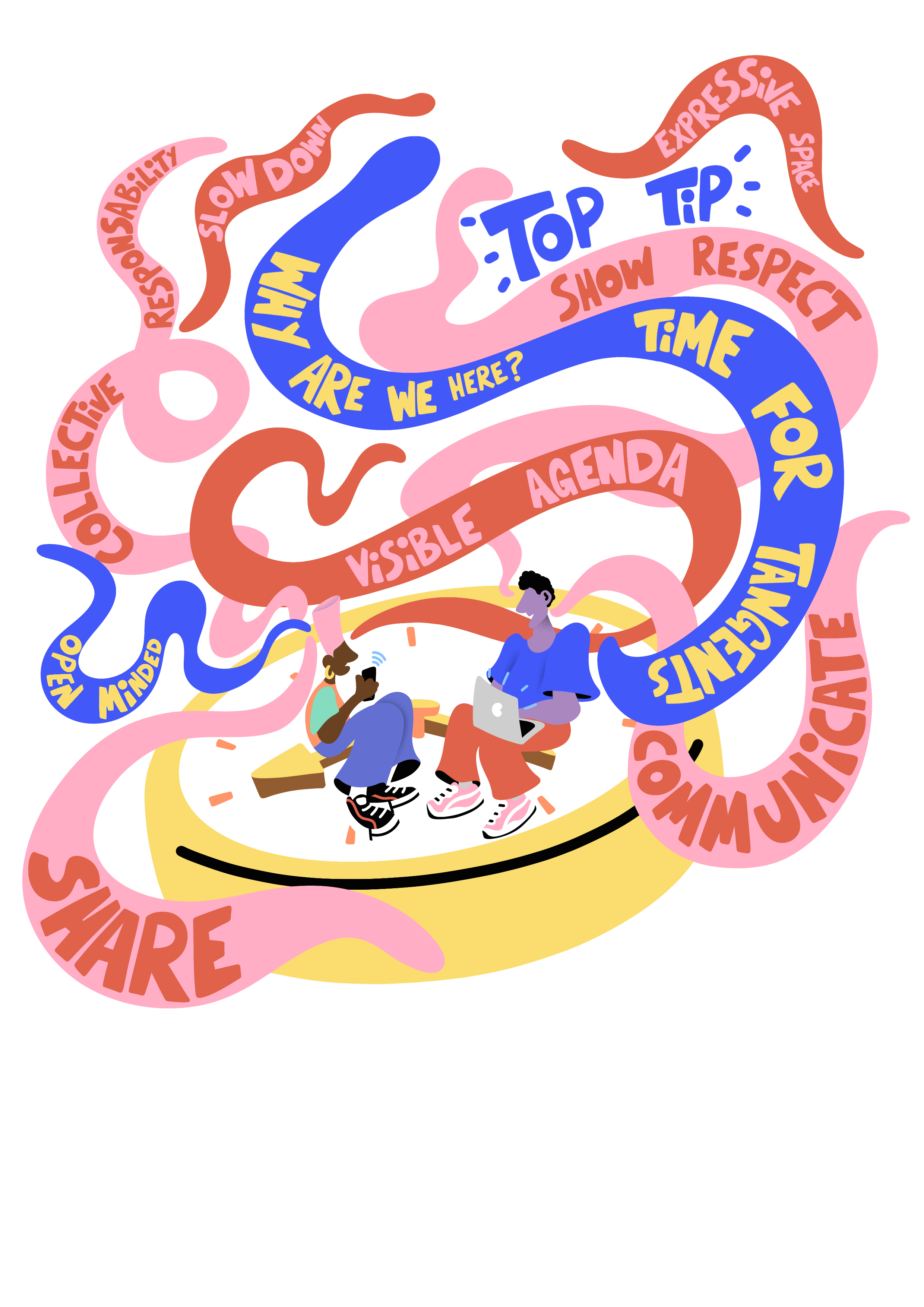HAPPY ACCIDENTS – EMBRACING THE CHAOS OF COLLABORATION
What can collaborating with brain injury survivors teach you about co-creating with others? Laura Owens of Headway East London shares the charity’s fascinating insights and offers some top tips for your own practice.
How often does everything go exactly according to plan? Can you think of a time when your original approach to a task had to change because of things outside your control? The truth is everyone constantly revises and adapts the way they work, sometimes without even realising it.
When collaborating with multiple people, flexibility and adaptation are a prerequisite. However, with some groups, such as people living with brain injury, this negotiation becomes more significant. It requires walking a tightrope between the structure of supportive facilitation and the chaos of creative curveballs. At Headway East London, we like to refer to the latter as “happy accidents” and embrace them. In fact, it’s where some of our best ideas come from.
So, what can you learn from our experiences of collaborating with people living with brain injuries? We hope that by sharing our processes, more people will be encouraged to leap into the unknown and experience the joys that come from working with others.
Who we are
Headway East London is a charity supporting people affected by brain injury. Working across thirteen London boroughs, we offer specialist support and services for over 200 survivors, family, friends and carers in the local area each week. This includes a day centre, community-based services, advice and advocacy work, and regular support groups. We call the people engaged with these services ‘members’ and consider them valuable assets, collectively responsible for the maintenance and success of the community.
Our mission is to empower our community of brain injury survivors and their families to imagine new possibilities filled with creativity, embracing diversity and backed by specialist support. Our vision is that brain injury survivors experience a world which is accessible to them, and where their contributions are valued and celebrated.
At our day centre in Hackney, we run a range of projects enabling survivors to take part in creative practice (covering art, music, food and more), while constantly looking for new audiences and partners to help develop it further. In recent years we’ve collaborated with the Barbican Centre, Whitechapel Gallery and Autograph ABP; developing new skills while showcasing the amazing talents of an often-overlooked group.
One of our commitments in this work is around the practice of co-production. Members are at the centre of everything we do: they’re actively involved in designing new projects, developing new ideas and helping to make decisions at different stages. The aim of this approach is to shift the narrative about group work from one which is consultative and extractive, to one which is collaborative, equitable and empowering.
In practice: Recruitment
For many years, Headway East London has included a member on the interview panel for any new hires. We decided to deepen this involvement when recruiting for a Public Engagement and Communications Manager in 2022.
Before advertising the role, members were invited to give feedback about the priorities they wanted to see included in the job description. During shortlisting, a member was invited to join the panel. The team reviewed all applications and interview questions before agreeing on an accessible interview document for all panel members to use on the day.
Following this, members of the Public Engagement Steering Group were invited to submit questions they wanted to ask at a second stage member-led online interview. Each member was supported to ask one question, and the structure and content of the interview were agreed upon in advance. All participating members were invited to feed back before a final decision was made by the staff team and circulated to all involved.
Seeking member involvement from such an early stage helped establish collective responsibility and understanding about the recruitment process, and ensured that our new hire was already familiar to and endorsed by the group of members they would be working closely with.
Into the unknown…
One of the biggest challenges for us when working in a group is the invisible elements. Brain injury is often referred to as a hidden disability. While some effects, such as movement or speech, may be immediately apparent, there are many things that can be difficult for people to understand or detect. Typically, some of the more common challenges can be around memory, concentration, fatigue, behaviour and emotions, and information processing. There are also many people who live with secondary conditions – some of which are directly related to their injury and others which aren’t. Some brain injury survivors have insight into these and can be open about discussing them, but others might not be able to or are unaware of them.
‘Sometimes I ask a lot of questions, maybe without realising that I have asked the same question ten times, but in Headway I don’t feel worried about having to ask again and again because they will know why I ask so much. They will just answer me and not make me feel… anyway… that’s very important for me. It has helped me to be more upfront, more aware of what’s going on around me.’
– Lina, Headway member
‘At the start, I just didn’t tell anybody, but then my behaviour changed and I kept cancelling and not turning up to things. I’ve lost friends because of this. They’d say things like, “I saw her yesterday and she looked fine”. I really struggle with my fatigue, but I’m not the type of person to be that open and explain it. Just having one busy day can have an effect for days.’
– Natasha, Headway member
Put plainly, the experience of brain injury is incredibly diverse and unique to each person. Similar challenges may present in completely different ways and require varying approaches when collaborating as a group.
A good rule of thumb when approaching this kind of work is to slow everything down. The pace we might consider manageable is likely to be inaccessible for a number of people participating, and it is better to ensure everyone feels able to make a meaningful contribution than to rush through a task list. This is particularly important during instances of co-creation; projects which involve people at the earliest stages of decision-making will require much lengthier timelines to support more in-depth planning and multiple accessible approaches.
‘For one-to-one conversations, I’m fine, but if I’m with a group of people, that’s when I’m really struggling to keep up. I will try and say something, but if I don’t say it right away, it’s gone. Then everyone is chatting and has moved on…it makes me feel in myself a bit silly.’
– Sean, Headway member
Activity – What’s in your brain?
For the people we work with, their brain has undergone a life-altering change which can be hard to explain. How would you attempt it? You’ll need a pen and paper, and you can do this exercise alone.
Take five minutes to draw what the inside of your brain looks like without using any words. Try not to be too scientific and move away from the biology of the physical brain: think about the thoughts and feelings you might want to capture.
What makes you, YOU? Get creative! Maybe it’s one particular scene or a collection of different zones. Maybe it has a distinct shape, but it can also be an abstract image which conveys something.
As an extra step, think about or try explaining this drawing to someone without talking. How would you approach this? What help would you need to communicate your most important points?
In practice: Steering Group
As part of a desire to co-produce more of our work at Headway East London, in 2018 the communications and public engagement team set up a Steering Group consisting of members and volunteers from across the charity’s services. The group is an open space for people to share ideas, make decisions, and monitor department progress and projects. There is no strict membership, some will come to every meeting while others drop in based on their interest level. We encourage people to commit to time-specific or ongoing projects, but we’re also mindful of the different levels of engagement each person wants or is capable of at any given time.
Meetings are generally held monthly, but can run more or less frequently depending on activity. Each meeting has a focus or theme – sometimes this is an upcoming event or partnership project, and other times this is an area of development where the team would like member input, such as social media.
Access to the group has been an ongoing and constantly evolving consideration. When the group was first established, meetings were held in-person at the centre after session hours, and transport was arranged for members to attend. During the pandemic, when meetings moved online, it became clear that for some, this provided more flexibility, but for others, it proved a barrier to participation. Once in-person working resumed, we chose to take a hybrid approach and ran two sessions on the same topic; one in-person for members on different days across the week (encouraging new and spontaneous attendance from those who previously saw the group as fixed and separate) and a second online version for those who attended on other days. Some members even choose to make their contributions separately to the group, in a smaller and more relaxed environment. Meeting minutes are circulated to all attendees, and resulting actions and achievements are revisited at future meetings.
In recent years, the group has been involved in developing our public-partnership programme, and has driven content and awareness-raising campaigns with the communications team. The group has also organised and project-managed a large-scale art event and is currently co-curating a season of activity at the Barbican Centre.
TOP TIP
When working with a new group of people, ask ahead for any considerations or adaptations you might have to make. You might be able to make some assumptions, but don’t rely solely on this. Use the specialist knowledge of staff already working closely with these groups and ask them to brief you with enough time and detail.
Don’t worry about being an expert! While brain injury is complicated and varied, you’re also just working with a group of individual people with different characters, needs and interests. The one assumption you can make is that everyone present wants to take part and enjoy the process.
Adding fun to the agenda
The nature of collaborating with brain injury survivors means that flexibility is key. Not every meeting will run to the agreed order. Sometimes they might end up covering something entirely different. There may be topics or groupings which provoke strong reactions, or significantly shift the tone. There has to be a degree of trust in uncertainty during these cases. For every uncomfortable moment or delayed plan, it’s important to ensure everyone feels safe to participate and is comfortable that things may go wrong.
‘Friends told me I was more aggressive. Even now, I’m more likely to get involved in arguments than before. If I thought you were doing something wrong, before I might think it – now, I’d just tell you.’
– Barrie, Headway member
There’s also an abundance of opportunity. You’re working with a group of people who possess a unique insight into the world. They’ve been through a life-altering experience which means they may now view things in an entirely different way; often, they bring new and varied approaches you might not have previously imagined.
One thing we always try to prioritise in our work is a sense of fun and playfulness. There is an understandable heaviness which can come with brain injury; roles, skills and relationships have been taken away in an instant. When working together on projects, we’re rebuilding and moving this narrative on. While there are challenges, we want to celebrate this positive progress and any outcomes that may come from it – expected or not. Good humour and a commitment to fun opens up more routes to access, and encourages more participation at all levels.
‘Headway really promotes fun, whether that’s in the kitchen, in music or in Submit to Love Studios. Headway’s one of those places where, if you think about it, it’s possible, all you have to do is mention it, and it suddenly happens, and that’s an amazing thing!’
– Dave, Headway member
Activity – Sticking to the brief
In line with our thinking around “happy accidents,” we want you to explore a group situation where things might not always go to plan. You’ll need a few people for this game (at least five or six) and everyone needs their own pen and paper.
The first person becomes the “designer” tasked with drawing a fun image to go onto a brand’s new T-shirt, which will then go to the printers. They have one minute, and the image should be a fun and surprising scenario featuring an object/being and an action (for example, a dancing banana or a horse cooking lunch). They cannot show anyone or share their thoughts as they do this.
Pass this paper along to the next person and ask them to close their eyes and draw the scene in 30 seconds on their own paper before passing it along to the next person. Ask that person to write down the scenario they see before passing along again.
Repeat the process of drawing/writing until you get back to the first person. What does this final scene look like? Would this still fit the original brief? Is there anything new you really like or could use? Discuss as a group what each person saw/did, and talk about how you might amend this final image before giving it back to the printers.
Open dialogues and ongoing journeys
When approaching all this work, it’s important to consider what the term “collaboration” means to each person. For some, it’s being involved from the very seed of an idea and supporting its growth at every stage. For others, it’s merely about creative expression and seeing their contribution have some impact. For everyone, it should be about valuing the input of peers and learning from the process.
Communication is key here. Expectations need to be set early on: establishing what level of input people expect and where the limits are to achieving this. Similarly, the methods in which you collaborate won’t suit or be accessible to everyone. In all of these cases, you should be asking: How do we make this process better for participants? What needs to change or happen to help them engage more fully? The answers might not be immediately clear or actionable, but the questions bear repeating, so everyone keeps moving forward in a co-production journey.
TOP TIP
Build in time for tangents. This is true of any group, but particularly one where some people might not be able to control the instinct to divert focus or attention. Keep the original agenda visible (or regularly revisit) to ensure everyone is reminded why they are meeting, but balance this with providing space for expression. You never know what nuggets of insight you may discover!
Think about collectively setting some “agreements” early on to help guide some of the more challenging aspects of unexpected group work. Consider things like allowing people enough time to talk without interruption, showing respect for everyone in the group when it comes to sharing strong views or opinions, and addressing the behaviours that aren’t acceptable. You can then refer to these during the session if required.
In practice: Matter magazine
In 2018, the communications team at Headway East London was pondering its next campaign. Keen to showcase the creative talents of the charity’s membership, while raising the profile of brain injury, they came up with the idea of creating and self-publishing a culture magazine. It was co-produced by more than 30 staff and survivors, and the team shared roles in editorial, design and writing. No one involved had previous experience in this area, so there was a shared agreement that every step in the process was a learning opportunity, that everyone was there to support one another, and that there were no guarantees.
Monthly editorial meetings were held to agree on the scope, purpose, theme and structure of the publication. Smaller groups took responsibility for certain aspects of development, including editorial and design. The meeting space also facilitated peer-to-peer feedback sessions on submitted work. For some contributors, this marked the first time they had publicly shared their experiences in writing or had creative responsibilities since their injury.
A key insight from the process was recognising the levels of participation members wanted or needed from a collaboration. Some simply wanted to write their contributions, gain feedback from peers, and make any resulting amends, happy making their own personal mark. Others wanted more in-depth involvement: contributing to wider questions about outreach, audience, and impact. The project made space for both – the monthly meetings were protected as open sharing spaces and a place to make big, key decisions around the magazine’s development; smaller groups would deal with the details and logistics and report back.
As a result of the project, the printed magazine sold out its run and was nominated for a Stack Independent Magazine Award, introducing Headway East London’s work to new audiences and raising vital funds. Members also developed new skills and confidence with writing, and a number have gone on to write guest articles on other websites.
Other Complete World podcasts
Other Complete World is an audio series made at Headway East London, a creative community for survivors of brain injury in Hackney, in collaboration with the Barbican Centre and DISRUPT. The series invites neurodiverse artists and thinkers into conversation with other figures in the worlds of arts and creativity. Through these connections, we want to get closer to the meaning of culture and the worlds we share.






